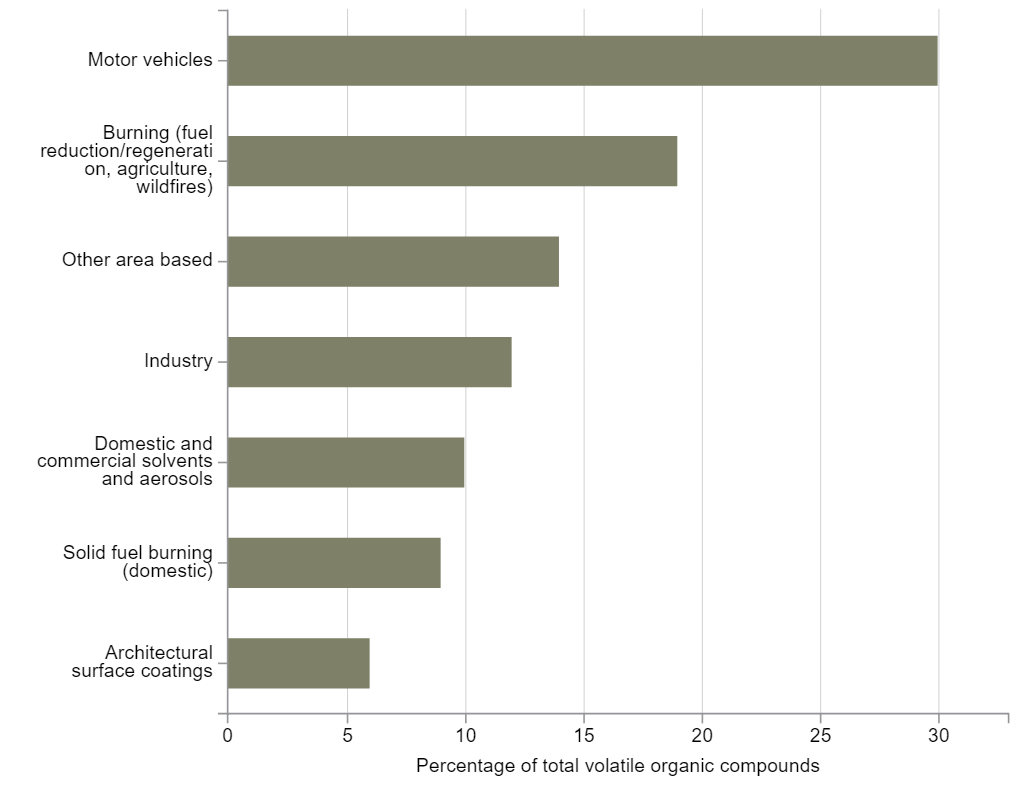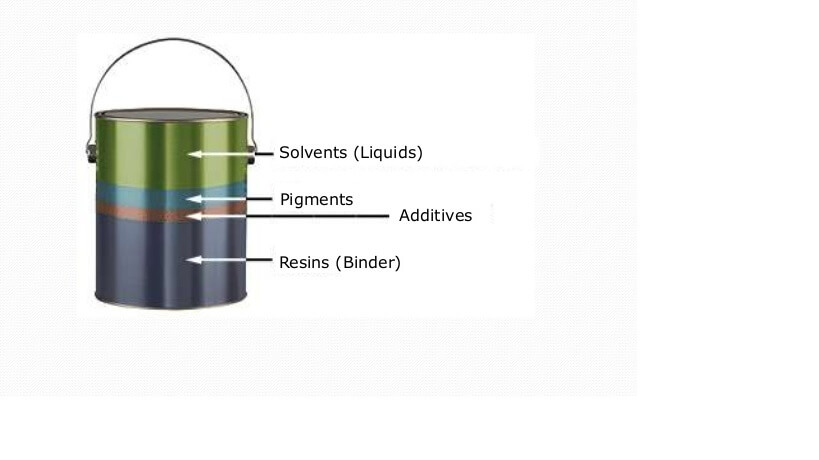Volatile organic compounds (VOCs) are a group of carbon-based products that are able to vaporize at room temperature. Historically VOCs were quite common in coating products, but can still be found in many different materials despite their disadvantages.
Sources of Volatile Organic Compounds (VOCs)
VOCs can originate from either indoor or outdoor sources. The indoor sources include building materials such as paints, varnishes or sealants, as well as home and personal products such as cleaners, disinfectants, pesticides, air fresheners, cosmetics and deodorants. Other sources of indoor VOCs are tobacco smoking, dry cleaned clothing and glues and permanent markers for arts and crafts products.
The outdoor sources for VOCs includes gasoline and diesel emissions, wood burning, industrial emissions, and oil and gas extraction and processing. Figure 1 shows the percentage of VOC emissions from various sources.

Figure 1. Sources of volatile organic compounds (VOCs) 2013–2014.
From Figure 1 it is clear that the percentage of VOC emissions from domestic products is much lower than emissions from outdoor sources such as motor vehicles. However, a recent study conducted by the US Environmental Protection Agency (EPA) showed that the concentration of indoor VOCs is much higher (about 10 times more) than outdoors. In addition, the EPA's Office of Research and Development "Total Exposure Assessment Methodology (TEAM) Study" showed that the percentage of VOCs is about 2 to 5 times greater in houses than outside. This high concentration is unrelated to the house's location (e.g., whether in rural or highly industrialized areas).
Health Effects of VOCs
Different VOCs have different health effects, which range from being highly toxic to benign. However, the biggest problem lies in breathing low levels of VOCs for a long period of time, which might increase the risk of health problems especially in those who suffer from asthma or are sensitive to chemicals. The health effects can include:
- Eye, nose and throat irritation
- Headaches, loss of coordination and nausea
- Damage to the liver, kidney and central nervous system
- Some organics can cause cancer
The symptoms associated with VOC exposure include eye and respiratory irritation, headaches, dizziness, visual disorders and memory impairment.
Outdoor VOCs have the same negative health effects, plus their reaction with nitrogen oxides produces photochemical oxidants, a type of hazardous air pollutant that is harmful to the ozone layer.
Due to the above mentioned health problems, regulatory efforts were made to reduce the VOCs emitted from consumer and industrial products. This article emphasizes the efforts to reduce VOCs emissions from paints and other coating products used in the corrosion industry, and the safety equipment that should be used by workers to protect themselves from the adverse health effects created by prolonged exposure to VOCs.
However, before explaining the efforts made to reduce VOCs emissions, we must first explore the components of coatings and what substances are responsible for VOC emissions.
Coating Composition
As illustrated in Figure 2, a liquid applied coating is composed of pigments, ad ditives, binders and solvents. (To learn more about these components, read The Composition of a Paint Coating.)

Figure 2. The composition of liquid applied coatings.
Pigment
A pigment is a discrete particulate solid used to change specific properties of the coating. Pigments don't dissolve in the coating but are suspended within it. They can have multiple functions, including changing the color, protecting the binder from weathering, improving water resistance, and providing inhibitor protection or cathodic protection.
Additive
Additives are usually liquid components in the coating that are added in small amounts to perform a specific function such as to prevent the coating from settling, reduce foaming or aid the coating application by increasing the coat's flow and wetting. Additives can also increase the UV resistance or increase or decrease the gloss. Additives could be called the secret ingredient of the coating that helps a manufacturer outperform competitors that sell the same coating type.
Binder
The binder is the main building block of the coating and supplies most of the heavy-duty functions of the material. The coating name is usually derived from the binder or the resin (e.g., epoxy, polyurethane, acrylic). In the coating's curing process the resin is converted from a liquid-like form (to aid in application) to a solid state that forms a protective film on the substrate. Therefore it must be able to resist chemical and physicals change in the environment and be able to tolerate variability in the application process. In addition, a binder should dry in an acceptable time frame.
Solvent
Some of the resins used as binders are solids at room temperature, so they must be liquefied to facilitate proper application. Solvents are added to liquefy the binder and to facilitate application. Solvents play a fleeting role in protective coatings. Once they are applied they evaporate and leave the solid binder adhering to the substrate. However because of health and environmental regulations and the effect that organic solvents have on the ozone layer, many high VOC coatings have been banned in several parts of the world. (VOCs and other health hazards are discussed in the article The Dangers of Typical Corrosion Prevention Solutions.)
Two common high VOC coatings are evaporation cured chlorinated rubber coatings and vinyls. Since the 1990s coating manufacturers sought alternative technologies that minimize or eliminate the need for solvents. Solvent-free coatings are now commonly used in many parts of the world, and new solvent-free or very high solids coatings are being developed.
In the coming section we will explore the actions taken to reduce VOC emissions, especially for corrosion prevention coatings.
Techniques to Reduce VOC Emissions
Because we are putting a large emphasis on the VOCs emitted from coatings we will explain how to reduce VOC emissions in your paint line and then we will discuss the safety equipment that can be used to reduce the painter's exposure to VOCs.
Reduce the amount of paint sprayed at a target
The term transfer efficiency refers to the amount of paint that is deposited on the substrate or the target compared to the total amount of paint being sprayed. By increasing the transfer efficiency we reduce the total amount of paint sprayed and reduce the amount of paint lost. This will reduce the VOCs and will also increase the lifetime of the paint booth filters. Transfer efficiency can be increased by using different spray technologies and techniques. The transfer efficiency of applicator technologies from the least to the most efficient are:
Reduce the amount of solvent used in the paint
An increasing trend in the coating industry is to use low VOC paints that are less harmful to the environment and human health than high VOC paints.
In addition, the solvent usage can be reduced if the components are mixed at the correct ratio. A plural component airless sprayer, which is designed to mix the paints closer to the gun, can reduce the flushing waste by up to 80%. This design ensures that the materials are mixed at the correct proportion before they are sprayed; this means lower VOCs and less wasted paint. However, a major drawback of this technique is its higher cost compared to traditional airless spray equipment.
Try to automate your paint activity
Paint booths are hazardous environments and the painter working in these booths is exposed to toxic fumes and explosive chemicals on a daily basis. Automating the paint activity will reduce material consumption by about 30%. It will also increase the quality of the substrate being painted and reduce the health risk that the painters are exposed to. The advantages of automating your paint activity include:
- Lower labor costs
- Improved quality
- Lower material usage
- Increased safety
- Lower healthcare costs and liability
- Reduced waste and VOCs
- Reduced energy costs
- Increased production
Automation is not always feasible, especially if the paint activity must be performed in the field where no paint booths are available. However, if there were a possibility of factory coating the substrate then it would be advantageous to automate the painting activity.
Ways to Reduce the Painter's Exposure to Harmful VOCs
Several steps can be taken to reduce the painter's exposure to harmful VOCs, especially with regard to the use of respirators. Several types are available:
- Air supplied helmets or hoods cover the entire head and neck and provide the wearer with a supply of clean dry air at low pressure through a filtered air supply. They provide the maximum protection against vapor, fumes, dust and dirt that can harm the respiratory system. These respirators are used for work performed in confined spaces such as tanks. Sometimes they are mandatory for spray applied coatings that contain an isocyanate component.
- Air supplied mask respirators operate from an external air supply and may cover the mouth and nose only. They don't provide the same degree of protection as the air supplied helmet provides. It is highly recommended that workers use eye protection googles if they are using air supplied mask respirators.
- Organic vapor respirators cover the nose and mouth and use cartridges that are designed to remove organic vapors by chemical absorption. It is extremely important that the correct cartridges are used and replaced periodically; otherwise the respirator won't be effective. Additionally, workers should wear eye protection googles when using this type of respirator, as they don't provide eye protection.
(Other tips can be found in Writing Safety into Your Coating Specification.)
Conclusion
Volatile organic compounds (VOCs) are indispensable pollutants that come from a variety of sources. Due to their negative health and environmental effects, steps were taken to reduce the amount of VOCs produced.
VOCs are emitted from, among other substances, coatings used in the corrosion protection industry. Since the 1990s manufacturers have been trying to find new paint formulations with a lower VOC content due to environmental regulations. However, paints containing VOCs are still in use. Several techniques are available that reduce the VOCs produced from the paint, as well as personal protection equipment (PPE) that should be worn by workers to protect them from the adverse health effects of VOCs.